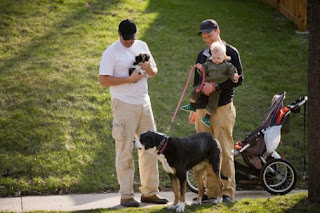At Morris K9 Campus, we know how important your dog is to you…so the day you lose your dog is probably one of the worst days of your life. Rather than panic, we have some tips you can take to effectively find your dog. A quick response coupled with neighborhood networking will increase the odds of getting your furry friend back pronto. The goal is to distribute information about the situation to as many people and places as you can, so enlist the help of friends and family in the search effort.
IDs, Please!
It is essential for dogs to wear a collar and ID tag with your name and a current phone number on it. Although microchips can be very useful in locating a lost dog, they are only as good as the information provided to the chip’s company. Make sure to renew the microchip service and update your contact information regularly.
Follow the Trail
As soon as you notice that your dog is missing, ask family members and neighbors when they last saw your dog. For smaller dogs, search under beds, in closets, dark places, small places, behind bulky furniture. You might also find it successful to shake a food dish, treat jar or favorite toy to lure your dog out of a hiding place.
If you’ve determined that your dog is not in or near your home, take a slow ride or walk around the neighborhood and bring along a recent photo to show neighbors. Check under porches and shrubs, and ask neighbors to check in sheds and garages just in case your dog was accidentally locked in.
Man the Phones
First call animal control agencies, shelters and rescue groups in your area. Then check in with shelters daily. If there aren’t any shelters nearby, contact the police.
Advertise
One of the oldest tricks in the book is to create a “lost dog” flyer. Stick with one image or design, so that a consistent message will stick in people’s minds. Large, bold headlines work best. A photo of your dog is essential, and make sure the image copies well. Include your dog’s breed, sex, color, age, weight, distinguishing features, and where and when he was last seen. It’s important to describe your dog accurately. Finally, place your name and multiple phone numbers for both yourself and a friend or family member to be contacted if your dog is found.
Some of the best places to post a lost dog flyer are:
- Dog parks
- Pet supply stores and groomers
- Vet offices
- Grocery and convenience stores
- Gas stations and laundromats
- Bars, cafes and restaurants
- Lamp posts and trees
- Around schools
Be sure to attach flyers securely in outdoor areas and reinforce paper with lamination or another material, and be sure to ask permission before posting your flyers on private property.
The internet is yet another great resource to get the word out. Send emails describing your lost dog to friends, colleagues and family members in the area, and ask them to pass on the info. You can also post messages to animal forums and message boards; lots of parks and dog runs have online communities.
Don’t give up on your dog if you don’t get any immediate leads. Your hard work will likely pay off, and many lost dogs have found their way back home.





No comments:
Post a Comment